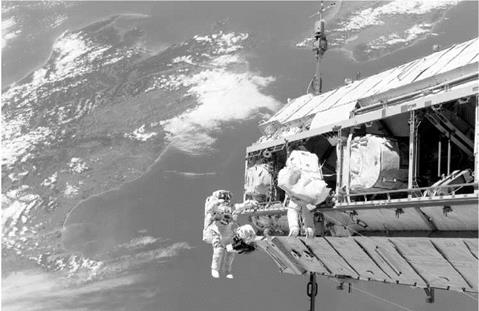Flight log
This was one of the most challenging missions in the history of the program. During the 13-day mission, the crew rewired the ISS power system and continued
|
Installing the P5 trass assembly: NASA astronaut Robert L. Curbeam and Swedish ESA astronaut Christer Fuglesang participate in the first of three EYAs. |
the construction phase by installing the P5 truss assembly. The flight also featured the exchange of ISS resident crew member Thomas Reiter with Sunita Williams.
Originally planned for a December 7 launch, the mission was delayed 48 hours due to low cloud cover, as no favorable conditions were expected to support a launch until December 9. The first nighttime launch in four years (due to post – Columbia safety limits for ascent photography), the ascent to orbit went without a problem. This was the first mission to feature the Advanced Heath Management System (AHMS) designed to improve the safety of the SSME. On this flight only performance data were collected, but on future flights the system would cut off the SSME if it detected a failure was about to occur.
The next day, the crew used the orbiter boom sensor system mounted on the end of the RMS to sweep the orbiter’s surface carefully, surveying for any damage incurred during ascent. The survey revealed no significant problems and the 2-day approach to the ISS continued.
However, a wing inspection was subsequently called for after a minor vibration reading on a port wing sensor was recorded. Analysis of inspection imagery determined that the heat shield could support a safe reentry and no further inspection was required. After backflipping the orbiter to allow the ISS crew to visually and photographically inspect the heat shield, Discovery was docked with the station on December 12. Following integrity checks and hatchopening ceremonies, Williams officially became a member of the ISS-14 crew and Reiter joined the STS-116 crew.
The installation of the P5 truss was supported by three EVAs. Shortly after docking, the truss was lifted out of the payload bay and passed to the station’s robot arm, where it was suspended overnight. The following day (December 12) Curbeam and Fuglesang conducted a 6h 36min EVA to attach the P5 truss, as well as replacing a failed camera that would be required to support future EVA tasks. Launch locks were removed and the astronauts completed plugging in the new segment to allow the P6 segment to be attached to the end of the P5 unit in readiness for when it was moved from its temporary location. A number of get – ahead tasks were also completed. At the end of the EVA the backbone of the ISS had increased by a further 11 feet (3.35 m).
The second EVA on December 14 lasted 5 hours, with the two crew members continuing the rewiring to incorporate the new truss. Despite problems fully retracting the P6 solar array (with only 17 of the 231 bays or panels folded as designed), its retraction was sufficient to allow the P4 array to rotate and track the Sun, generating power to the station. The astronauts were also able to relocate the two main carts on the rails of the main truss, place a thermal covering over the station’s RMS, and install bags of tools for future EVA support.
For the third EVA on December 16, Williams joined Curbeam to complete the rewiring operations. They also attached three bundles of Russian debris shield panels on the exterior of the Zvezda Service Module. These would be fully installed on future EVAs. After installing a robotic arm grapple fixture, the pair returned to the P6 array to continue its retraction, shaking it while it was reeled in one bay at a time. At the end of the attempt, 65% of the array had been retracted. This EVA lasted 7 hours 31 minutes.
The final EVA on December 18, by Curbeam and Fuglesang, was added to complete the P6 retraction. It would be relocated during a later 2007 mission. After securing insulation on the station arm, the EVA ended at 6 hours 38 minutes. At the completion of EVA activities, STS-116 had logged a total of 25 hours 45 minutes. In addition, Curbeam had accumulated a career total of 45 hours 34 minutes EVA time across two of his three Shuttle missions, setting a new record.
While the EVAs were being conducted, the crews transferred over two tons of food, water, and equipment to the station under the direction of Load Master Joan Higginbotham. They also transferred about two tons of unwanted equipment and samples from experiments into the Spacehab module for the return to Earth. Just two minutes short of a full eight days of joint operations, Discovery was undocked from ISS on December 19. The next day, the crew again inspected the orbiter heat shield for any damage incurred during orbital flight. They also deployed three small scientific satellites, checked out the landing systems, and completed stowage for reentry.
Originally scheduled for December 21, the landing was postponed due to the addition of the fourth EVA. Inclement weather at the Cape then forced a cancellation of the first attempt there and it was too windy to land at Edwards. However, conditions at the Cape turned dramatically to allow a landing on the second attempt on December 22. A total of 17,900 commands were sent on this mission
setting a new record, with over 5,000 more commands from MCC-H than for any previous flight.
Milestones
251st manned space flight 147th U. S. manned space flight 117th Shuttle mission 33rd flight of Discovery 20th Shuttle ISS mission 7th Discovery ISS mission First Swedish citizen in space First Swedish astronaut to perform EVA First flight of Advanced Health Management System New record of 17,900 commands sent from MCC-H New Shuttle EVA record (accumulative) of 45 h 34 min set by Curbeam












